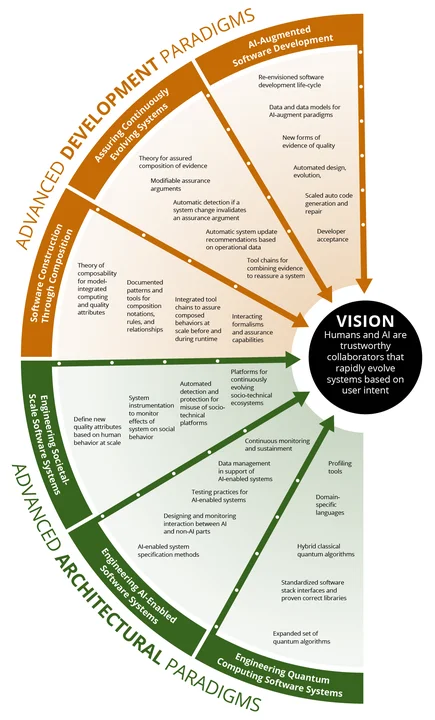Architecting the Future of Software Engineering: A Research and Development Roadmap
This post is coauthored by John Robert, Mark Klein, Doug Schmidt, Forrest Shull, John Foreman, Ipek Ozkaya, Robert Cunningham, Charlie Holland, Erin Harper, and Edward Desautels
Software is vital to our country’s global competitiveness, innovation, and national security. It also ensures our modern standard of living and enables continued advances in defense, infrastructure, healthcare, commerce, education, and entertainment. As the DoD’s federally funded research and development center (FFRDC) focused on improving the practice of software engineering, the Carnegie Mellon University (CMU) Software Engineering Institute (SEI) is leading the community in creating a multi-year research and development vision and roadmap for engineering next-generation software-reliant systems. This blog post describes that effort.
Software Engineering as Strategic Advantage
In a 2020 National Academy of Science Study on Air Force software sustainment, the U.S. Air Force recognized that “to continue to be a world-class fighting force, it needs to be a world-class software developer.” This concept clearly applies far beyond the Department of Defense. Software systems enable world-class healthcare, commerce, education, energy generation, and more. These systems that run our world are rapidly becoming more data intensive and interconnected, increasingly utilize AI, require larger-scale integration, and must be considerably more resilient. Consequently, significant investment in software engineering R&D is needed now to enable and ensure future capability.
Goals of This Work
The SEI has leveraged its connections with academic institutions and communities, DoD leaders and members of the Defense Industrial Base, and industry innovators and research organizations to:
- identify future challenges in engineering software-reliant and intelligent systems in emerging, national-priority technical domains, including gaps between current engineering techniques and future domains that will be more reliant on continuous evolution and AI
- develop a research roadmap that will drive advances in foundational software engineering principles across a range of system types, such as intelligent, safety-critical, and data-intensive systems
- raise the visibility of software to the point where it receives the sustained recognition commensurate with its importance to national security and competitiveness
- enable strategic partnerships and collaborations to drive innovation among industry, academia, and government.
Guided by an Advisory Board of U.S. Visionaries and Senior Thought Leaders
To succeed in developing our vision and roadmap for software engineering research and development, it is vital to coordinate the academic, defense, and commercial communities to define an effective agenda and implement impactful results. To help represent the views of all these software engineering constituencies, the SEI formed an advisory board from DoD, industry, academia, research labs, and technology companies to offer guidance. Members of this advisory board include the following:
- Deb Frincke, advisory board chair, Associate Laboratory Director for National Security Sciences, Oak Ridge National Laboratory
- Michael McQuade, vice president for research, Carnegie Mellon University
- Vint Cerf, vice president and chief internet evangelist, Google
- Penny Compton, vice president for software systems, cyber, and operations, Lockheed Martin Space
- Tim Dare, deputy director for prototyping and software, Office of the Under Secretary of Defense for Research and Engineering (previous position)
- Sara Manning Dawson, chief technology officer enterprise security, Microsoft
- Jeff Dexter, senior director of flight software & cybersecurity, SPACEX
- Yolanda Gil, president, Association for the Advancement of Artificial Intelligence (AAAI); Director of Knowledge Technologies, Information Sciences Institute at University of Southern California
- Tim McBride, president, Zoic Studios
- Nancy Pendleton, vice president and senior chief engineer for mission systems, payloads and sensors, Boeing Defense, Space and Security
- William Scherlis, director Information Innovation Office, DARPA
In June 2020, the SEI assembled this board to leverage their diverse perspectives and provide strategic advice, influence stakeholders, develop connections, assist in executing the roadmap, and advocate for the use of our results.
Future Systems and Fundamental Shifts in Software Engineering Require New Research Focus
Rapidly deploying software with confidence requires fundamental shifts in software engineering. New types of systems will continue to push beyond the bounds of what current software engineering theories, tools, and practices can support, including (but not limited to):
- Systems that fuse data at a huge scale, whether for news, entertainment, or intelligence: We will need to continuously mine vast amounts of open-source data streams (e.g., YouTube videos and Twitter feeds) for important information that will in turn drive decision making. This vast stream of data will also drive new ways of constructing systems.
- Smart cities, buildings, roads, cars, and transport: How will these highly connected systems work together seamlessly? How will we enable safe and affordable transportation and living?
- Personal digital assistants: How will these assistants learn, adapt, and engage in home and business workflows?
- Dynamically integrated healthcare: Data from your personal device will be combined with hospital data. How do we meet stringent safety and privacy requirements? How do we evaluate assurance in a highly data-driven environment?
- Mission-level adaptation for DoD systems: DoD systems will feature mission-level construction of new integrated systems that combine a range of capabilities, such as intel, weapons, and human/machine teaming. The DoD is already moving in this direction, but how can we increase confidence that there will be no unintended consequences?
A Guiding Vision of the Future of Software Engineering
Our guiding vision is one in which the current notion of software development is replaced by the concept of a software pipeline consisting of humans and software as trustworthy collaborators who rapidly evolve systems based on user intent. To achieve this vision, we anticipate the need for not only new development paradigms but also new architectural paradigms for engineering new kinds of systems.
Advanced development paradigms, such as those listed below, lead to efficiency and trust at scale:
- Humans leverage trusted AI as a workforce multiplier for all aspects of software creation.
- Formal assurance arguments are evolved to assure and efficiently re-assure continuously evolving software.
- Advanced software composition mechanisms enable predictable construction of systems at increasingly large scale.
Advanced architectural paradigms, as outlined below, enable the predictable use of new computational models:
- Theories and techniques drawn from the behavioral sciences are used to design large-scale socio-technical systems, leading to predictable social outcomes.
- New analysis and design methods facilitate the development of quantum-enabled systems.
AI and non-AI components interact in predictable ways to achieve enhanced mission, societal, and business goals.
Research Focus Areas
The fundamental shifts and needed advances in software engineering described above require new areas of research. In close collaboration with our advisory board and other leaders in the software engineering community, we have developed a research roadmap with six focus areas. Figure 1 shows those areas and outlines a suggested course of research topics to undertake. Short descriptions of each focus area and its challenges follow.

- AI-Augmented Software Development. At almost every stage of the software development process, AI holds the promise of assisting humans. By relieving humans of tedious tasks, they will be better able to focus on tasks that require the creativity and innovation that only humans can provide. To reach this goal, we need to re-envision the entire software development process with increased AI and automation tool support for developers, and we need to ensure we take advantage of the data generated throughout the entire lifecycle. The focus of this research area is on what AI-augmented software development will look like at each stage of the development process and during continuous evolution, where it will be particularly useful in taking on routine tasks.
- Assuring Continuously Evolving Systems. When we consider the software-reliant systems of today, we see that they are not static (or even infrequently updated) engineering artifacts. Instead, they are fluid—meaning that they are expected to undergo continuing updates and improvements throughout their lifespan. The goal of this research area is therefore to develop a theory and practice of rapid and assured software evolution that enables efficient and bounded re-assurance of continuously evolving systems.
- Software Construction through Compositional Correctness. As the scope and scale of software-reliant systems continues to grow and change continuously, the complexity of these systems makes it unrealistic for any one person or group to understand the entire system. It is therefore necessary to integrate (and continually re-integrate) software-reliant systems using technologies and platforms that support the composition of modular components, many of which are reused from existing elements that were not designed to be integrated or evolved together. The goal of this research area is to create methods and tools (such as domain specific modeling language and annotation-based dependency injection) that enable the specification and enforcement of composition rules that allow (1) the creation of required behaviors (both functionality and quality attributes) and (2) the assurance of these behaviors.
- Engineering Socio-Technical Systems. Societal-scale software systems, such as today’s commercial social media systems, are designed to keep users engaged to influence them. However, avoiding bias and ensuring the accuracy of information are not always goals or outcomes of these systems. Engineering societal-scale systems focuses on prediction of such outcomes (which we refer to as socially inspired quality attributes) that arise when we humans as integral components of the system. The goal is to leverage insights from the social sciences to build and evolve societal-scale software systems that consider qualities such as bias and influence.
- Engineering AI-enabled Software Systems. AI-enabled systems, which are software-reliant systems that include AI and non-AI components, have some inherently different characteristics than those without AI. However, AI-enabled systems are, above all, a type of software system. These systems have many parallels with the development and sustainment of more conventional software-reliant systems. This research area focuses on exploring which existing software engineering practices can reliably support the development of AI systems, as well as identifying and augmenting software engineering techniques for the specification, design, architecture, analysis, deployment, and sustainment of systems with AI components.
- Engineering Quantum Computing Systems. Advances in software engineering for quantum are as important as the hardware advances. The goals of this research area are to first enable current quantum computers so they can be programmed more easily and reliably, and then enable increasing abstraction as larger, fully fault-tolerant quantum computing systems become available. Eventually, it should be possible fully integrate these types of systems into a unified classical and quantum software development lifecycle.
Help Shape Our National Software Research Agenda
Along with the advisory board, our research team has examined future trends in the computing landscape and emerging technologies; conducted a series of expert interviews; and convened multiple workshops for broad engagement and diverse perspectives, including a workshop on Software Engineering Grand Challenges and Future Visions co-hosted with the Defense Advanced Research Projects Agency (DARPA). This workshop brought together leaders in the software engineering research and development community to describe (1) important classes of future software-reliant systems and their associated software engineering challenges, and (2) research methods, tools, and practices that are needed to make those systems feasible. An upcoming SEI blog post will provide a synopsis of what was covered in this workshop.
Your feedback would be appreciated on the software engineering challenges and proposed research focus areas to help inform the National Agenda for Software Engineering Study. Please email info@sei.cmu.edu to send your thoughts and comments on the software engineering study & research roadmap or to volunteer as a potential reviewer of study drafts. Thank you.
More By The Author
More In Software Engineering Research and Development
PUBLISHED IN
Get updates on our latest work.
Sign up to have the latest post sent to your inbox weekly.
Subscribe Get our RSS feedMore In Software Engineering Research and Development
Get updates on our latest work.
Each week, our researchers write about the latest in software engineering, cybersecurity and artificial intelligence. Sign up to get the latest post sent to your inbox the day it's published.
Subscribe Get our RSS feed
